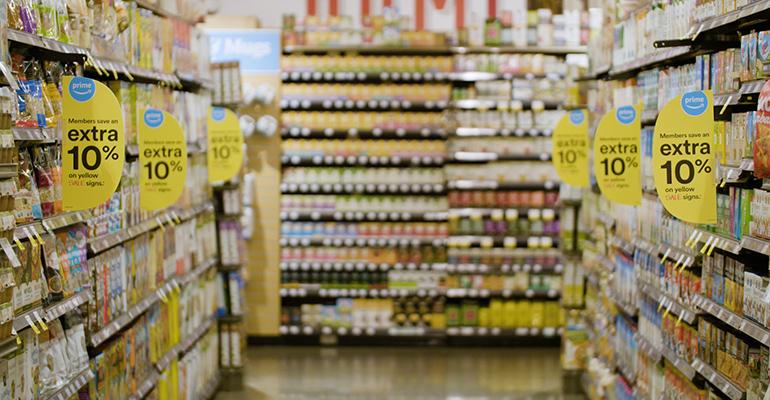At a time when discretionary purchases are top of mind for shoppers, almost one in five have bought groceries from Amazon so far on Prime Day 2021, according to consumer data specialist Numerator.
Prime Day, Amazon’s annual online sales event, runs June 21 and 22 this year. Through 9 a.m. ET Tuesday morning, 18.9% of Prime Day customers purchased grocery items, based on nearly 11,100 orders from almost 5,700 unique households identified by the live Numerator Amazon Prime Day Tracker. Chicago-based Numerator noted that the grocery purchases represent “a significant percentage on a day historically known for consumer electronics sales.”
Grocery ranked sixth in purchase share for day one of Prime Day. The top five categories were household essentials (29% of Prime Day buyers), home and garden (27.1%), apparel and footwear (25.2%), consumer electronics (24.9%), and health and beauty care (24.9%). Rounding out the top categories were smart home devices (14/9%), pet care (13.9%), toys and video games (13.4%), books/videos/media (10.6%) and baby items (7.9%).
More than half (54%) of Prime Day shoppers only looked at Amazon for their purchase, Numerator reported. Twenty-five percent considered Walmart/Walmart.com, 20% Target/target.com and 9% warehouse clubs, with 7% considering Best Buy/Best Buy.com, grocery retailers or department stores. What’s more, 78% of Prime Day buyers didn’t compare Amazon prices with any other website or store, and 59% of shoppers made purchases only from Amazon on Prime Day.
Amazon-branded products accounted for 29% of grocery purchases, fifth behind smart home devices (63% of Prime Day purchases), household essentials (41%), consumer electronics (39%), and apparel and footwear (35%). In a sign of how prevalent and varied Amazon private labels have become, Numerator said 17% of buyers in household essentials, 15% in baby, 14% in health and Beauty, 14% in pet care, and 21% apiece in home/garden and apparel/footwear were unsure if the items they purchased were Amazon brands.
Through Prime Day 2021’s first 32 hours, the average spend per order was $47.14, down from $54.64 on Prime Day 2020 and $58.91 on Prime Day 2019, Numerator’s tracker revealed. Thus far, 44% of orders were $20 or less, compared with 24% of order for more than $100. By household, the average Prime Day spend was about $92, with 11% spending more than $200.
Forty-five percent of households shopping Prime Day had placed more than two orders for the event’s first 32 hours, and 6% placed over five orders. Half of Prime Day shoppers said they purchased items included in Prime Day deals, and 24% said they bought the same items they typically buy on Amazon. Seven percent used Prime Day to get started on holiday shopping, and 3% said they purchased back-to-school items.
Of Prime Day 2021 customers, 78% reported shopping on Prime Day in previous years, and 96% said they likely would shop Prime Day again if Amazon held a second event later in 2021. And of Prime Day shoppers in both 2020 and 2021, 45% said they prefer a June event, while 20% favor an October event. Last year, Prime Day was held Oct. 13 and 14, with Amazon saying it pushed back the event due to COVID-19.
Overall, 98% of Prime Day shoppers were members of Amazon's Prime customer benefits program. Eighty-three percent said they had joined Prime before the COVID-19 pandemic (prior to March 1, 2020), and 10% joined Prime after the start of the pandemic.




